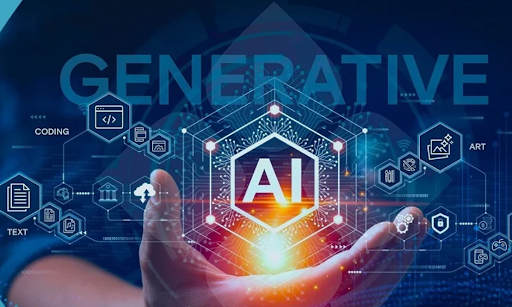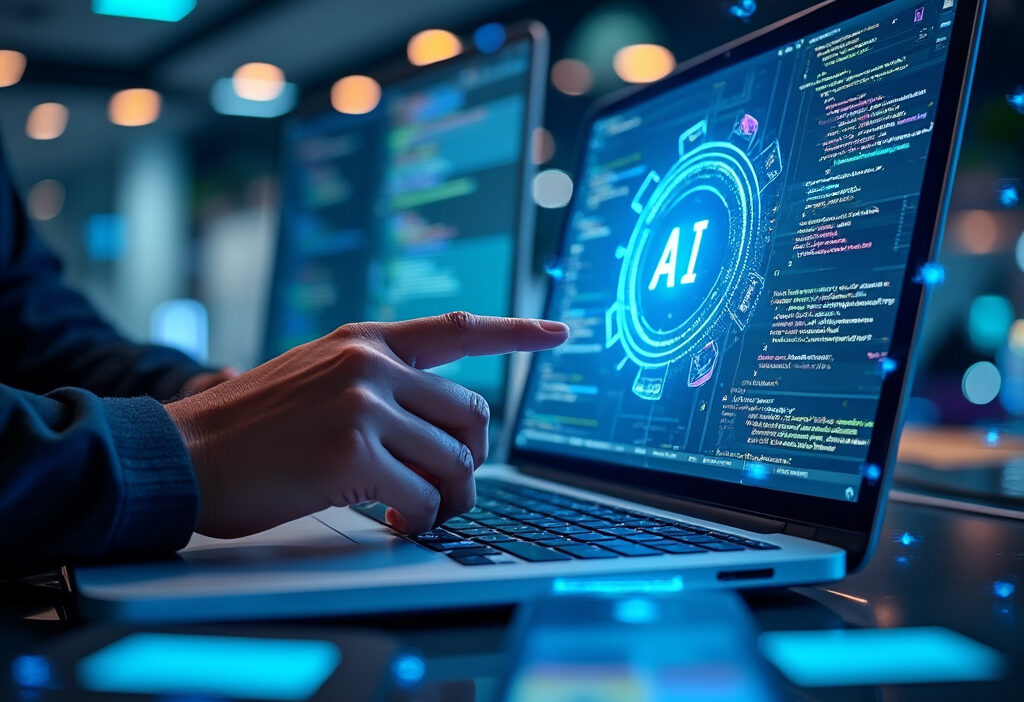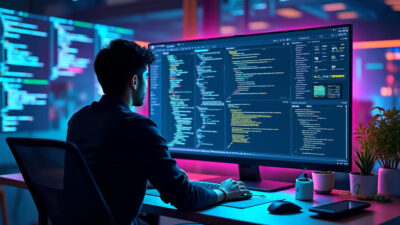Generative AI Revolutionizing Software Development and Code Creation in 2025
Generative AI is set to redefine the landscape of software development and code creation by 2025. This article delves into how AI-driven tools are automating coding, enhancing creativity, and streamlining workflows. From automating mundane tasks to generating complex algorithms, generative AI is not just a tool but a revolutionary force in the tech industry.
The Rise of Generative AI in Tech
The tech industry has witnessed a seismic shift with the rise of generative AI, transforming it from a niche research topic into a cornerstone of modern software development. Early AI systems were limited to rule-based algorithms, but advancements in neural networks and deep learning have birthed models capable of understanding, interpreting, and even generating human-like code. By 2025, generative AI has evolved beyond simple autocompletion tools into sophisticated systems that can architect entire applications, debug complex systems, and optimize performance with minimal human intervention.
The journey began with foundational models like OpenAI’s GPT-3, which demonstrated the potential of large language models (LLMs) to interpret and generate text. As these models grew in scale and sophistication, they were fine-tuned for code generation, leading to tools like GitHub Copilot. By 2025, these systems have matured into full-fledged AI pair programmers, capable of understanding context, suggesting architectural patterns, and even refactoring legacy codebases. The integration of reinforcement learning and symbolic AI has further enhanced their ability to reason about software design, making them indispensable in agile development environments.
Beyond LLMs, generative adversarial networks (GANs) and diffusion models have also found applications in software development. GANs, for instance, are now used to generate synthetic test data, simulate edge cases, and even model system behaviors under stress. The fusion of these technologies has democratized software creation, enabling smaller teams to compete with tech giants by leveraging AI-driven productivity boosts. As we delve deeper into the mechanics of these models in the next chapter, it becomes clear that generative AI isn’t just a tool—it’s redefining the very fabric of how software is built.
Understanding Generative AI Models
Generative AI models have become the backbone of modern software development, enabling machines to understand, interpret, and even write code with remarkable accuracy. Among the most influential models are GPT variants (Generative Pre-trained Transformers) and GANs (Generative Adversarial Networks), each serving distinct yet complementary roles in code generation.
GPT-based models, such as OpenAI’s Codex and DeepMind’s AlphaCode, excel in understanding natural language prompts and translating them into functional code. These models are trained on vast repositories of open-source code, learning syntax, patterns, and best practices across multiple programming languages. By leveraging transformer architectures, they predict the next logical sequence in code, making them ideal for autocompletion, bug fixes, and even generating entire modules from high-level descriptions.
On the other hand, GANs—though traditionally used for image and audio synthesis—are now being adapted for software development. A GAN consists of two neural networks: a generator that creates code snippets and a discriminator that evaluates their correctness. This adversarial process refines the output, ensuring syntactically and semantically valid code. While less common than GPT models in this domain, GANs show promise in generating optimized algorithms and detecting vulnerabilities through iterative improvement.
Both model types rely on self-supervised learning, where they analyze unlabeled data to infer underlying structures. Fine-tuning with domain-specific datasets further enhances their precision, allowing them to adapt to niche programming paradigms. As these models evolve, they are not just mimicking human-written code but discovering novel optimizations, reshaping how developers approach problem-solving. Their ability to learn from data and generalize across contexts marks a paradigm shift, setting the stage for deeper automation in software engineering.
Automating Code Generation
Generative AI has rapidly evolved into a cornerstone of modern software development, automating code generation at an unprecedented scale. By 2025, AI-powered tools are no longer just assisting developers—they are fundamentally reshaping how code is written. These systems can generate code snippets, entire functions, and even full applications, drastically reducing manual effort and accelerating development cycles.
One of the most transformative aspects is the ability of generative AI to interpret natural language prompts and translate them into functional code. Developers can describe a feature in plain English, and the AI generates syntactically correct, context-aware implementations. For example, a prompt like “create a REST API endpoint for user authentication” might yield a complete Flask or Express.js function, complete with error handling and security best practices. This eliminates repetitive boilerplate coding, allowing developers to focus on higher-level architecture and logic.
Beyond snippets, AI can assemble entire modules by stitching together pre-trained patterns. Models like OpenAI’s Codex or GitHub’s Copilot X analyze vast repositories to suggest optimizations, detect edge cases, and even refactor legacy code. The result is not just faster output but also higher-quality code, as AI leverages collective knowledge from millions of projects.
However, automation doesn’t mean replacing human judgment. AI-generated code still requires validation, testing, and integration—tasks where developer expertise remains irreplaceable. The synergy between human intuition and machine efficiency is where the true revolution lies, setting the stage for the next chapter’s exploration of how AI enhances creativity rather than supplanting it.
As adoption grows, ethical considerations—like bias in training data or over-reliance on automation—will need addressing. Yet, the undeniable efficiency gains position generative AI as an indispensable ally in the developer’s toolkit by 2025.
Enhancing Developer Creativity
In 2025, generative AI has evolved from a mere automation tool to a collaborative partner that amplifies developer creativity. Rather than replacing human coders, AI now acts as a co-pilot, offering innovative suggestions that push the boundaries of conventional problem-solving. Developers are no longer bogged down by repetitive tasks—thanks to the automation discussed earlier—but instead focus on higher-level design and creative challenges, with AI providing real-time inspiration.
One of the most transformative aspects is AI’s ability to propose unconventional solutions that a developer might not immediately consider. For instance, when optimizing an algorithm, AI can suggest hybrid approaches combining techniques from different domains, such as merging graph theory with machine learning optimizations. These insights stem from AI’s vast training on diverse codebases and technical literature, enabling it to cross-pollinate ideas in ways humans might overlook.
Additionally, AI-powered tools now assist in refactoring and aesthetic improvements, ensuring code is not just functional but elegant. By analyzing patterns from high-quality open-source projects, AI recommends structural enhancements that improve readability and maintainability. This allows developers to focus on innovation rather than cleanup.
Key ways AI enhances creativity include:
- Idea generation: Proposing multiple architectural designs for a given problem, allowing developers to explore alternatives rapidly.
- Optimization hints: Identifying performance bottlenecks and suggesting novel optimizations, such as parallelization strategies or memory-efficient data structures.
- Learning acceleration: Offering contextual explanations for advanced concepts, helping developers quickly grasp and apply new techniques.
Far from making developers obsolete, AI has become an indispensable ally, freeing them to think bigger and experiment fearlessly. As we move into the next chapter, we’ll see how these creative enhancements integrate seamlessly into streamlined development workflows, further accelerating project delivery.
Streamlining Development Workflows
In 2025, generative AI has become an indispensable ally in streamlining software development workflows, drastically reducing inefficiencies and accelerating project timelines. By automating repetitive and time-consuming tasks, AI allows developers to focus on higher-value problem-solving while ensuring precision and speed at every stage of the development cycle.
One of the most transformative applications is in debugging. AI-powered tools now analyze code in real-time, identifying potential errors before they manifest into critical issues. Unlike traditional static analyzers, these systems leverage vast datasets of past bugs and fixes, offering context-aware suggestions that often resolve issues with a single click. This not only minimizes downtime but also prevents costly post-deployment patches.
Testing has also undergone a revolution. AI-driven test automation frameworks generate comprehensive test cases by understanding application behavior, edge cases, and user flows. These systems dynamically adjust test coverage based on risk assessment, ensuring no critical path is left untested. For example, AI can simulate thousands of user interactions in minutes, uncovering performance bottlenecks or security vulnerabilities that manual testing might miss.
Beyond debugging and testing, AI optimizes continuous integration and deployment (CI/CD) pipelines. By predicting build failures or deployment risks, AI suggests optimal merge times and resource allocations, reducing pipeline delays. Additionally, AI-enhanced version control systems intelligently manage code conflicts, streamlining collaboration across distributed teams.
The result is a development process that is not just faster but also more reliable. As AI continues to refine these workflows, the next chapter will explore how these advancements translate into measurable improvements in software quality, further cementing AI’s role as a cornerstone of modern development.
The Impact on Software Quality
Generative AI is fundamentally transforming software quality by minimizing human errors and enforcing best practices across the development lifecycle. Unlike traditional methods, where manual oversight is prone to lapses, AI-driven tools now analyze, suggest, and even auto-correct code in real-time, ensuring higher reliability and robustness. By leveraging vast datasets of high-quality code repositories, these systems identify patterns and anti-patterns, flagging potential vulnerabilities before they escalate into critical issues.
One of the most significant contributions of generative AI is its ability to standardize code quality. Developers often introduce inconsistencies due to varying skill levels or project pressures. AI tools, however, enforce uniform coding standards—whether it’s proper indentation, naming conventions, or architectural principles—reducing technical debt. For instance, AI-powered linters and static analyzers now go beyond syntax checks, offering contextual improvements like optimizing database queries or refactoring inefficient loops.
Moreover, generative AI enhances testing accuracy. Traditional testing relies heavily on human-written test cases, which may miss edge scenarios. AI-generated tests, however, simulate thousands of potential execution paths, uncovering hidden bugs that manual testing might overlook. This is particularly impactful in complex systems like microservices or distributed architectures, where interdependencies are hard to track manually.
The ripple effect of these advancements is evident in reduced post-deployment failures. By catching errors early and ensuring adherence to best practices, generative AI minimizes costly rollbacks and security breaches. However, as we’ll explore in the next chapter, this shift isn’t without ethical challenges—especially concerning over-reliance on AI and the potential erosion of human expertise. For now, though, the focus remains clear: generative AI is setting a new benchmark for software quality, making robust, scalable, and secure applications the norm rather than the exception.
Ethical Considerations and Challenges
As generative AI becomes deeply integrated into software development by 2025, ethical dilemmas and challenges emerge alongside its transformative potential. One pressing concern is job displacement. While AI enhances efficiency and reduces errors, it also automates tasks traditionally performed by junior developers, such as boilerplate code generation or debugging. This shift raises questions about the future role of human developers—will they transition to higher-level architectural and strategic roles, or face reduced opportunities? Companies must balance AI adoption with workforce reskilling initiatives to mitigate disruption.
Another critical issue revolves around intellectual property (IP). Generative AI models are trained on vast datasets, often including publicly available code, which blurs the lines of ownership. If an AI produces code resembling proprietary snippets, who bears liability—the developer using the tool, the AI vendor, or the original code author? Legal frameworks lag behind technological advancements, leaving gaps in accountability. Clear licensing models and ethical training data practices are essential to avoid litigation and foster trust.
Bias and fairness also pose challenges. AI-generated code may inadvertently inherit biases present in training data, leading to exclusionary or flawed software outcomes. Developers must audit AI outputs rigorously, ensuring alignment with ethical standards. Additionally, over-reliance on AI risks stifling creativity, as teams may default to AI-suggested solutions without critical evaluation.
Finally, security vulnerabilities introduced by AI demand attention. Malicious actors could exploit AI tools to generate harmful code or automate cyberattacks. Proactive measures, such as robust validation pipelines and ethical guidelines for AI use, are vital to safeguarding software integrity. While generative AI revolutionizes development, addressing these ethical challenges is crucial to harnessing its benefits responsibly.
Case Studies of AI in Action
In 2025, generative AI has moved beyond theoretical potential to become a transformative force in real-world software development. Companies across industries are leveraging AI-powered tools to accelerate workflows, reduce errors, and unlock new creative possibilities. Here are three compelling case studies demonstrating AI’s impact.
1. Automated Legacy Code Modernization at a Financial Giant
A major bank faced the daunting task of migrating decades-old COBOL systems to modern Python frameworks. Using an AI-assisted refactoring tool, the team reduced manual effort by 70%. The AI analyzed legacy logic, generated equivalent Python code, and even flagged potential edge cases. What would have taken years was completed in months, with fewer bugs than traditional manual rewrites.
2. AI-Powered Debugging in a Global SaaS Platform
A cloud software provider integrated an AI debugging assistant into its CI/CD pipeline. The system analyzed thousands of past bug reports and code commits to predict vulnerabilities before deployment. In one quarter, it identified 40% of critical bugs autonomously, reducing production incidents by 35%. Developers reported spending 50% less time on debugging, allowing them to focus on feature innovation.
3. Generative Prototyping for a Gaming Startup
An indie game studio used AI to generate boilerplate code for physics engines and NPC behavior. By describing gameplay mechanics in natural language, developers received functional code snippets, cutting prototyping time from weeks to days. The AI also suggested optimizations, improving frame rates by 20%. This allowed the small team to compete with larger studios in delivering polished experiences.
These examples highlight how generative AI isn’t just automating tasks—it’s reshaping collaboration between humans and machines. As the next chapter explores, adapting to this shift requires strategic preparation, but the rewards are already evident in these success stories.
Preparing for an AI-Driven Future
As generative AI becomes an integral part of software development, developers and organizations must adapt to stay competitive in an AI-driven landscape. The transition requires a strategic approach, blending technical upskilling, process optimization, and ethical considerations.
Upskilling and Reskilling Developers
The role of developers is evolving from writing code manually to orchestrating AI tools effectively. Companies should invest in training programs that focus on:
- Prompt engineering: Crafting precise inputs to guide AI in generating high-quality code.
- AI-augmented debugging: Leveraging AI to identify and fix errors faster.
- Model fine-tuning: Customizing AI models for domain-specific tasks.
Developers must also deepen their understanding of AI limitations to avoid over-reliance and ensure human oversight remains central.
Adapting Development Workflows
Integrating AI into existing pipelines demands workflow restructuring. Teams should:
- Adopt AI-powered IDEs that offer real-time code suggestions and auto-completion.
- Implement continuous AI auditing to validate generated code for security and efficiency.
- Establish hybrid development cycles where AI handles repetitive tasks, freeing developers for innovation.
Ethical and Security Considerations
With AI generating code at scale, companies must address risks like intellectual property disputes, biased algorithms, and security vulnerabilities. Proactive measures include:
- Enforcing AI governance frameworks to ensure compliance and accountability.
- Regularly auditing AI outputs for biases and vulnerabilities.
- Maintaining human-in-the-loop reviews for critical systems.
Preparing for an AI-driven future isn’t just about adopting tools—it’s about fostering a culture of continuous learning and adaptability. Organizations that balance automation with human expertise will lead the next wave of innovation.
The Future Landscape of AI and Development
By 2025, generative AI is poised to fundamentally reshape the software development lifecycle, pushing beyond today’s code autocompletion and boilerplate generation. The next wave of advancements will likely focus on context-aware AI systems that understand not just syntax but the broader intent of a project, enabling them to propose architectural designs, optimize performance bottlenecks, and even predict potential security vulnerabilities before they emerge. These systems will act as collaborative partners, reducing the cognitive load on developers while accelerating innovation.
One key evolution will be the rise of self-evolving codebases, where AI continuously refactors and updates software based on real-world usage data. Imagine an AI that monitors application performance, identifies inefficiencies, and autonomously deploys optimizations—all while maintaining compliance with coding standards. This could drastically reduce technical debt and free developers to focus on higher-value tasks like user experience and strategic problem-solving.
Another frontier is multi-modal AI development, where generative models integrate natural language, visual inputs, and even voice commands to streamline prototyping. Developers might describe a feature in plain language, and the AI generates not just the code but also UI mockups and database schemas, bridging gaps between disciplines.
Ethical and governance challenges will intensify as AI takes on more decision-making roles. The industry must establish frameworks for accountability, especially when AI-generated code introduces bugs or biases. However, the potential is undeniable: by 2025, generative AI could democratize software creation, enabling smaller teams to compete with tech giants and unlocking unprecedented agility in development cycles. The future isn’t just about writing code faster—it’s about reimagining what’s possible when human creativity merges with machine intelligence.

Conclusions
Generative AI is transforming software development and code creation, offering unprecedented efficiency and innovation. As we look towards 2025, the integration of AI in development processes promises to enhance productivity, reduce errors, and foster creativity. The future of coding is here, and it’s powered by AI.



